Endocrine System Chapter Notes | Science Olympiad Class 8 PDF Download
What is Endocrine System?
- The endocrine system consists of ductless glands that release hormones directly into the bloodstream.
- These glands are known as endocrine glands and are characterized by their lack of ducts.
- The endocrine system works in coordination with the nervous system, though its responses are slower and more widespread.
- It relies on the cardiovascular system to distribute its hormones, making endocrine glands some of the most vascular tissues in the body.
- Hormones from endocrine glands are potent in very small quantities, so their circulating levels are typically low.
- The endocrine system includes cells and tissues not exclusively classified as endocrine glands but capable of hormone secretion, such as the hypothalamus, thymus, pancreas, skin, heart, and adipose tissues.
- Endocrinology is the study of the structure and function of endocrine glands and cells, and the diagnosis and treatment of endocrine disorders.
- Unlike other body systems, endocrine glands are not grouped together but are scattered throughout the body.
- Different hormone systems within the endocrine organs regulate body functions such as metabolism, growth, electrolyte balance, reproduction, and behavior.
- Most endocrine glands are regulated by a simple negative feedback mechanism, with their secretion controlled by the nervous and immune systems.
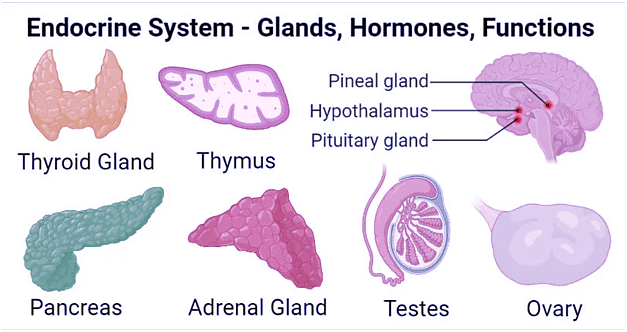
Glands and Hormones of the Endocrine System
The endocrine system consists of the following glands;
Hypothalamus and Pituitary Gland
- The hypothalamus is a small brain organ located below the thalamus, controlling the pituitary gland's secretion.
- It is connected to the pituitary gland by a stalk called the infundibulum, linking the endocrine and nervous systems.
- The hypothalamus secretes about nine hormones, with seven regulating the pituitary gland.
- These hormones are known as inhibiting or releasing hormones.
- The pituitary gland, a small pea-shaped organ about 1-1.5 cm in diameter, is located in the hypophyseal fossa of the sphenoid bone in the skull.
- The pituitary gland is divided into two distinct parts: the anterior pituitary (adenohypophysis) and the posterior pituitary.
- The anterior pituitary, made up of epithelial cells, constitutes about 70% of the gland and is supplied by a portal system for hormone circulation.
- The anterior pituitary's secretion is influenced by releasing hormones from the hypothalamus.
- The posterior pituitary, composed of neural tissue, is activated by action potentials from the hypothalamus.
- Hormones in the posterior pituitary are synthesized in hypothalamic nerve cell bodies, transported along axons, and stored in axon terminals, with their release into the bloodstream regulated by nerve stimuli from the hypothalamus.
- The pituitary gland's hormone secretion is regulated by a negative feedback mechanism.
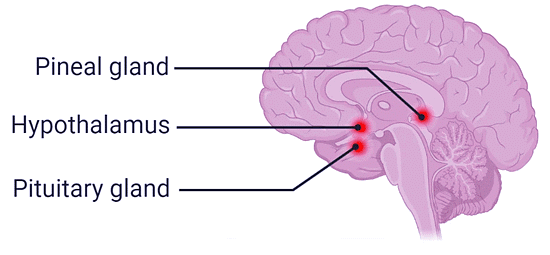
Hormones of the hypothalamus and pituitary gland
1. Growth Hormone
- Growth hormone is the most abundant hormone secreted by the anterior pituitary that stimulates the growth of body cells.
- The hormones stimulate the division of all body cells, but the bone and skeletal muscles are the most easily influenced.
- The release of growth hormone by the anterior pituitary is influenced by the growth hormone-releasing hormone and growth hormone-inhibiting hormone secreted by the hypothalamus.
- Growth hormone also affects the metabolism of certain organs in the body like the liver, heart, and kidneys.
2. Thyroid-stimulating hormone
- The thyroid-stimulating hormone stimulates the growth and activity of thyroid hormone, which itself is stimulated by the thyrotrophin releasing hormone from the hypothalamus.
- Thyroid-stimulating hormone is responsible for the regulation of the secretion of thyroid hormones, thyroxine (T4) and tri-iodothyronine (T3).
3. Adrenocorticotropic hormone
- The synthesis and release of adrenocorticotrophic hormone (ACTH) are regulated by the corticotrophin-releasing hormone from the hypothalamus.
- This hormone influences the adrenal cortex, which releases steroid hormones like cortisol.
- The level of ACTH is the highest at 8 am, which then falls to the lowest at about 6 pm.
4. Prolactin
- Prolactin is a hormone secreted during pregnancy that stimulates the mammary glands to produce milk.
- The production of prolactin is stimulated by prolactin-releasing hormone and inhibited by the prolactin inhibiting hormone, both produced by the hypothalamus.
- Besides, the sucking on the mammary gland post-childbirth also influences the levels of prolactin.
5. Gonadotrophin
- Gonadotrophins or sex hormones are released just before puberty in response to the luteinizing hormone-releasing hormone, also called gonadotrophin-releasing hormone.
- The appropriate levels of these hormones are essential at puberty to promote the mature functioning of the reproductive organs.
- The sex hormones in males and females that are involved in the proper functioning of the reproductive system are follicle-stimulating hormone and luteinizing hormone.
6. Oxytocin
- Oxytocin is released by the pituitary during childbirth as these affect the uterine smooth muscles and the muscles of the lactating breasts.
- Oxytocin is released by the posterior pituitary during childbirth to stimulate the sensory stretch receptors of the uterine cervix.
- Similarly, the suckling also generates a sensory impulse that influences the release of oxytocin which then triggers the contraction of milk ducts and ejection of milk.
7. Antidiuretic Hormone (ADH)
- Antidiuretic hormone or vasopressin is released by the posterior pituitary and is involved in the regulation of urine output.
- Vasopressin affects the permeability of the distal convoluted tubules and collecting tubules in the kidney.
- The release of ADH is regulated by the osmotic pressure of the blood circulating and the osmoreceptors in the hypothalamus.
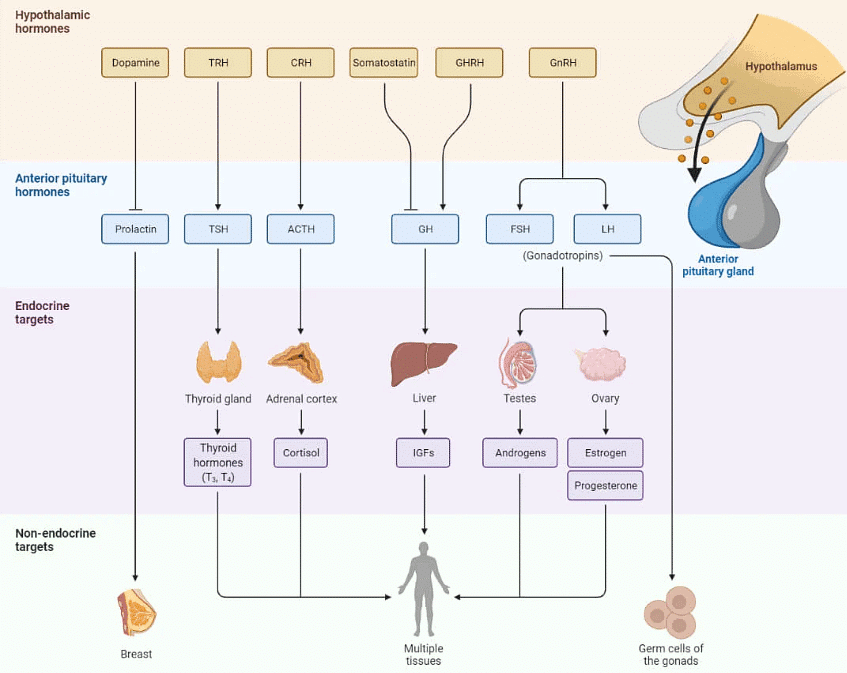
Thyroid Gland
- The thyroid gland is a butterfly-shaped bilobed gland that occurs on either side of the trachea.
- The two lobes of the gland are connected by a narrow piece of tissue called the isthmus.
- The two lobes of the gland function as a unit and produce two different types of hormones. The gland itself is made up of numerous microscopic spherical follicles surrounded by capillaries.
- The follicles are composed of epithelial cells that secrete the hormones into the lumen. The hormones are synthesized in the form of large precursor molecules called thyroglobulin.
- The thyroid gland is the only endocrine gland that can store large quantities of its secretory products, lasting up to 100 days.
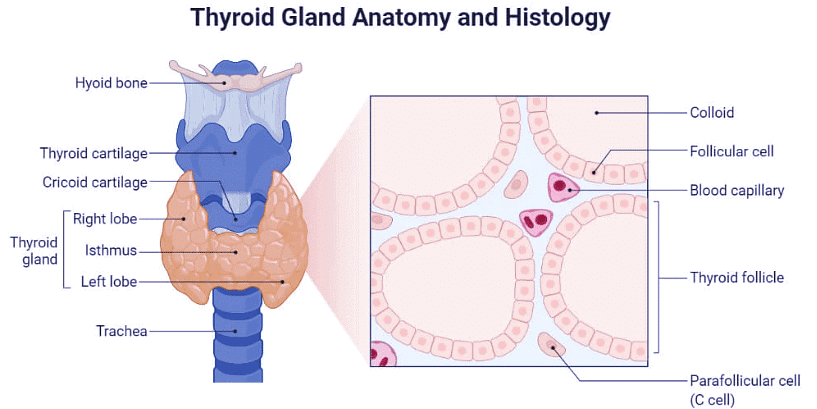
Hormones of the Thyroid Gland
Thyroxine and Tri-iodothyronine
- Thyroxine and tri-iodothyronine are the two hormones secreted by the thyroid hormone in response to the thyroid-stimulating hormone secreted by the pituitary gland.
- The hormones are named T3 and T4 to indicate the number of iodine atoms present in the molecule.
- Thyroid hormones increase the basal metabolic rate (BMR), which regulates the level of oxygen consumption under standard conditions.
- These are also involved in the proper functioning of the sodium-potassium pumps that are essential for the electrolyte balance in the body.
- The thyroid gland and thyroid hormones contain most of the iodine occurring in the body. The hormones are lipid-soluble and thus diffuse through the plasma membrane into the interstitial fluid and then to the blood.
Parathyroid Gland
- Parathyroid glands occur as four small glands embedded in the posterior side of either lobe of the thyroid gland.
- All four glands function as a unit producing parathyroid hormone (PTH) that targets the cells of the bones and kidneys.
- The primary function of the hormone is to regulate the levels of calcium, magnesium, and phosphates in the blood.
- The glands are surrounded by fine connective tissue capsules consisting of spherical cells arranged in columns.
- The endocrine cells of the parathyroid glands are termed principal or chief cells that are polygonal with round nuclei and acidophilic cytoplasm.
Hormones of the Parathyroid Gland
Parathyroid Hormone
- Parathyroid hormone is responsible for the regulation of blood calcium levels, which influences the absorption of calcium from the digestive system.
- Parathormone and calcitonin serve as complementary hormones in order to maintain the appropriate blood calcium level in the body.
- The maintenance of the calcium levels in the body is important as it the major constituent of structures like teeth and bones.
Adrenal Gland
- Adrenal glands occur at the upper surface of each kidney which can be further divided into two distinct parts with different structures and functions.
- The glands occur as flattened structures with a crescent moon shape, and the size varies with the age and physiological condition of the person.
- The two parts of the glands occur in concentric regions; adrenal medulla and adrenal cortex.
- The cortex and medulla of the adrenal glands are generally considered two different glands as these have different embryonic origins, functions, and morphological features.
- The adrenal cortex originates from the mesoderm, whereas the medulla originates from the neural crest.
- The adrenal cortex is further divided into three distinct zones, each of which secretes different hormones.
- The zona glomerulosa secretes mineralocorticoids, the zona fasciculata secretes glucocorticoids and the zona reticularis secretes androgens.
- The adrenal medulla occurs towards the center of the gland that consists of hormone-secreting chromaffin cells.
- The two important hormones secreted by the adrenal medulla are epinephrine and norepinephrine.

Hormones of the Adrenal Glands
1. Mineralocorticoids
- The primary mineralocorticoid is aldosterone which is involved in maintaining water and electrolyte balance in the body.
- The steroid hormone stimulates the reabsorption of sodium and excretion of potassium in the kidneys via a negative feedback mechanism.
- The secretion of aldosterone by the glands is regulated by the blood potassium level.
2. Glucocorticoids
- Cortisol is the primary glucocorticoid secreted by the adrenal cortex, but small amounts of corticosterone and cortisone can also be produced.
- The secretion of the hormone is regulated by the hypothalamus and the anterior pituitary.
- Glucocorticoids have different metabolic effects that are primarily concerned with the catabolism of biomolecules like proteins and fats.
3. Androgens
- Androgens are also secreted by the adrenal cortex in males, but the concentration of those androgens is so low that their effects are almost insignificant.
- In females, however, androgens are responsible for sex drive and can also be converted into estrogens by other tissues.
- Adrenal androgens stimulate the growth of auxiliary and pubic hair in males and females.
- The exact mechanism of regulation of androgen secretion is not yet understood, but it has been assumed that ACTH secretion is the principal drive.
4. Epinephrine or Adrenaline and Norepinephrine or Noradrenaline
- Adrenaline or epinephrine has a significant effect on the functioning of the heart and other metabolic processes.
- Norepinephrine is a postganglionic neurotransmitter of the sympathetic branch of the autonomic nervous system, which is then released into the blood.
- The primary function of these hormones is to regulate the sympathetic nervous system.
- In some cases, norepinephrine is converted into epinephrine within the chromaffin cells of the adrenal medulla.
Pancreas
- The endocrine part of the pancreas is the clusters of cells, called pancreatic islets or Islet of Langerhans.
- These occur in the form of a cluster of cells scattered throughout the gland. The hormones produced by the cells are released directly into the bloodstream.
- The pancreatic islets consist of three different types of cells; α cells, β cells, and δ cells. The three different cells secrete three distinct hormones. A minor fourth type of cell also occurs in the pancreas called the PP cells.
- A pancreas has more than 1 million islets, most of which are concentrated in the tail region of the gland.
- The origin of pancreatic islets is the same as pancreatic acinar tissues, the epithelial outgrowth from the endoderm. The activity of these islets is regulated by the blood glucose level.

Hormones of the Pancreatic Islets
1. Insulin
- Insulin is produced by the β cells, which are the most abundant cells of the gland. Insulin is a polypeptide that functions to lower the blood glucose level.
- Even though insulin is often associated with glucose levels in the blood, it also monitors the levels of amino acids and fatty acids.
- The secretion of insulin is regulated by the blood glucose level and some degree of parasympathetic stimulation.
2. Glucagon
- Glucagon is produced by the α cells, which are involved in increasing the blood glucose by different metabolic pathways.
- The release of glucagon is stimulated by low blood glucose levels and decreased insulin levels.
Pineal Gland
- The pineal gland is the small gland present at the roof of the third ventricle attached to the surface by a short stalk composed of nerves.
- The gland develops from the embryonic neuroectoderm and consists of modified neurons called pinealocytes.
Hormones of the Pineal Gland
Melatonin
- Melatonin is the main hormone secreted by the pineal gland, regulated by light and dark cycles.
- Melatonin levels peak at midnight and drop to their lowest around midday.
- Melatonin helps regulate circadian and diurnal rhythms by acting on the hypothalamus.
- It also inhibits the growth and development of sex organs by affecting gonadotropin synthesis.
Thymus
- The thymus is a lymphoid organ located between the lungs, involved in synthesizing white blood cells.
- It is active until puberty, after which it gradually shrinks and is replaced by fat.
- As part of the immune system, the thymus is crucial for preventing autoimmunity.
- Before puberty, the thymus is important for producing T lymphocytes that defend against various antigens.
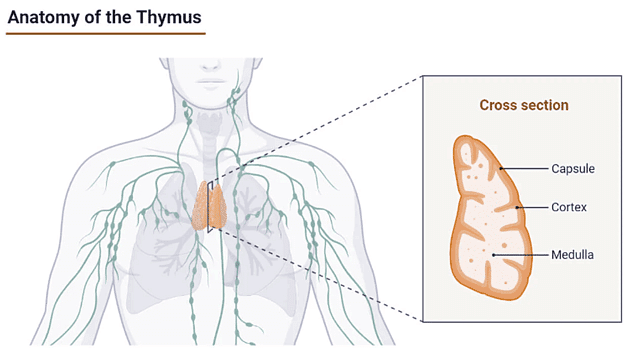
Hormone of the Thymus Gland
Thymosin
- Thymosin is the most important hormone produced by the thymus gland, which influences the immune response as well as stimulates the secretion of the pituitary gland.
- The hormone is also involved in the process of activation and differentiation of T cells into different types.
Gonads
- Gonads are endocrine glands that secrete steroid sex hormones similar to those of the adrenal cortex.
- Male gonads are the testes, while female gonads are the ovaries.
- Ovaries, located in pairs in the female abdominal cavity, produce female gametes and hormones, primarily estrogens and progesterone.
- In males, the testes are located in an extra-abdominal skin pouch called the scrotum and produce sperm and male sex hormones.
- Hormones from male and female gonads are the same as those from the adrenal cortex, but in higher concentrations.
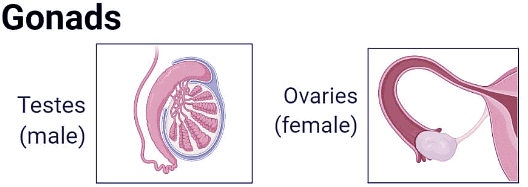
Hormones of the Gonads
1. Estrogen
- Estrogen is produced by the cells in the ovaries, which are essential for the maturation of the reproductive organs and the appearance of secondary sex characters in the females at puberty.
- Estrogens are analogous to male steroid testosterone. The level of estrogen in the body increases during puberty in order to promote oogenesis and follicle growth.
- The activity of estrogen results in the proper functioning of different reproductive parts like the uterine tubes, uterus, and vagina.
2. Progesterone
- Progesterone is produced by the corpus luteum during the menstrual cycle, which regulates the cycles and activates changes in the cervical mucosa.
- Most of the effects of the hormone are observed during pregnancy as it inhibits uterine mobility. The level of progesterone increases more than that of estrogen during pregnancy.
3. Testosterone
- Testosterone is produced by the testes, which stimulates the maturation of sex organs, their development, and the appearance of secondary sex characters.
- The release of testosterone is maintained by the release of gonadotrophin-releasing hormone produced by the hypothalamus.
Functions of Endocrine System
Functions of the endocrine system include:
- The primary function is maintaining body homeostasis to ensure stable biochemical processes across organs.
- Endocrine hormones balance the growth and differentiation of body cells, facilitating individual development.
- It enhances the body's ability to respond to various internal and external stressors.
- As it includes reproductive organs, the endocrine system is essential for developing reproductive behavior.
- It integrates and balances the functions of different body systems.
- Endocrine glands, such as the thyroid gland, are crucial for proper metabolic processes.
- It closely interacts with the nervous system to maintain a balanced relationship.
Diseases and Disorders of Endocrine System
Disorders in the endocrine system result from hypersecretion or hyposecretion of hormones.
1. Diseases and Disorders of the Pituitary Gland
- Hypersecretion
- Hypersecretion of anterior pituitary hormones can lead to gigantism and acromegaly.
- These conditions are caused by the overproduction of growth hormone-releasing hormone by the hypothalamus.
- Gigantism is characterized by large bones and increased height, while acromegaly results in large extremities due to thickened bones and soft tissues.
- Hyposecretion
- Hyposecretion of pituitary hormones can cause ischaemic necrosis, dwarfism, and Frohlich’s syndrome.
- Ischaemic necrosis involves deficient stimulation of target glands and reduced secretion by glands controlled by the pituitary.
- Dwarfism is due to a deficiency of growth hormone in childhood.
- Hyposecretion of ADH can lead to diabetes insipidus, a rare condition marked by the kidney's inability to reabsorb water.
2. Diseases and Disorders of the Thyroid Gland
- Hypersecretion
- Hypersecretion of thyroid hormones (T3 and T4) causes hyperthyroidism.
- Conditions include Grave’s disease (an autoimmune disorder where antibodies mimic thyroid-stimulating hormone) and toxic nodular goiter (activated nodules secrete T3 and T4).
- Hyposecretion
- Hyposecretion of thyroid hormones leads to hypothyroidism, often seen as a simple goiter (enlarged thyroid due to low T4 and T3).
- This condition affects metabolic processes and might necessitate surgical removal of excess thyroid tissue.
3. Diseases and Disorders of the Adrenal Gland
- Hypersecretion
- Hypersecretion of cortisol results in Cushing’s syndrome, characterized by tissue breakdown, facial adiposity, reduced protein synthesis, and osteoporosis.
- Excess mineralocorticoids like aldosterone affect kidney function, leading to excessive ion and water reabsorption.
- Hyposecretion
- Hyposecretion of glucocorticoids causes reduced gluconeogenesis, low blood glucose, and muscle weakness.
- Hyposecretion of mineralocorticoids impairs kidney function, leading to sodium deficiency and potassium excess in the blood.
4. Diseases and Disorders of the Parathyroid Gland
- Hypersecretion
- Hypersecretion of parathyroid hormone increases blood calcium levels, often due to a benign parathyroid tumor.
- Hyperparathyroidism symptoms include muscle weakness, anorexia, constipation, and renal calculi.
- Hyposecretion
- Hyposecretion of parathyroid hormone (hypocalcemia) is rare and often manifests as tetany, anxiety, or paraesthesia, causing painful muscle spasms.
5. Diseases and Disorders of the Pancreatic Islets
- Diabetes Mellitus
- The most common endocrine disorder, diabetes mellitus, affects carbohydrate and fat metabolism due to insufficient insulin.
- Type 1 diabetes mellitus occurs in children and can be life-threatening if onset is sudden.
- Type 2 diabetes mellitus, accounting for 90% of cases, has a gradual onset and often goes undetected for long periods.
|
65 videos|119 docs|67 tests
|
FAQs on Endocrine System Chapter Notes - Science Olympiad Class 8
| 1. What is the main function of the endocrine system? |  |
| 2. What are some of the key glands in the endocrine system and what hormones do they produce? |  |
| 3. How does the hypothalamus and pituitary gland work together in the endocrine system? |  |
| 4. What is the role of the thyroid gland in the endocrine system? |  |
| 5. How does the pancreas function in the endocrine system? |  |















